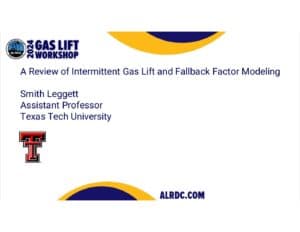A Review of Intermittent Gas Lift and Fallback Factor Modeling
Objective/Scope
At some point in the producing life of a gas lifted well, it is recommended to switch from continuous gas lift to some type of intermittent gas lift. Various methods such intermittent gas lift with a downhole pilot valve, gas-assisted plunger lift with a surfaced control valve, and chamber lift, involve lifting a liquid slug to surface using energy from expanding gasses below. As thousands of unconventional wells become candidates for late-life gas lift methods, the industry is renewing focus on understanding how to design, model, and optimize intermittent gas lift systems.
This study reviews past efforts to model intermittently lifted gas lift systems and presents ongoing work from a joint industry project. Models for fallback factor are emphasized that inform how to maximize liquid production rates.
Methods
A comprehensive literature review was conducted on the topics of intermittent gas lift and fallback factor modeling. This review includes numerical studies, field cases, and experiments conducted in test wellbores. Furthermore, a test wellbore is being equipped at Texas Tech for fallback factor characterization experiments.
Results
The synthesis of the literature review traces the historical development of intermittent gas lift and fallback factor modeling. Intermittent gas lift models have evolved from pseudo-steady state to complex numerical simulations based on mechanistic multiphase fluid flow concepts. We summarize past works and show that the fallback factor depends on a variety of factors including liquid slug length, velocity, tubing size, pilot valve characteristic, viscosity, and the presence of a plunger.
Conclusions
The literature review highlights the need for future research to validate intermittent gas lift and fallback factor models. Ongoing efforts in this direction are suggested as the focus of the Texas Tech Gas Lift Consortium.

